Galleries
David Ebony’s Top 10 Most Memorable Artworks of 2014
These major works of contemporary art were first seen or shown this year.
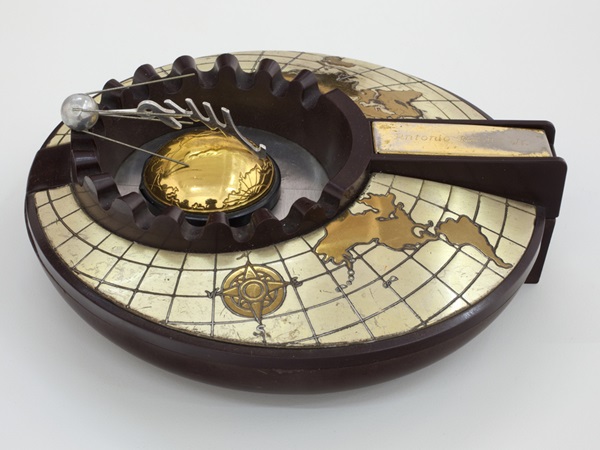
These major works of contemporary art were first seen or shown this year.

It was a banner year for the art market, and galleries and museums seemed to thrive. But what about artistic accomplishments? There certainly were some. Here are 10 of the most unforgettable artworks seen for the first time this year, even if they weren’t all created in 2014.
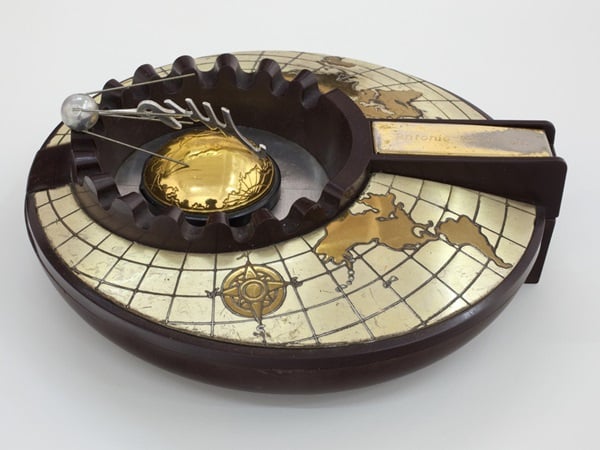
Gabriel Orozco, Satellite Sputnik on Ashtray (2014) at Marian Goodman.
Photo: Marian Goodman.
1.) Gabriel Orozco, Satellite Sputnik on Ashtray (2014) found objects in metal and plastic, in his Marian Goodman show this fall.
Among Gabriel Orozco’s many talents is his power to use abject found objects in potentially explosive combinations laden with new meanings. Take his infamous yogurt container lid installation at Marian Goodman, which practically launched the Mexican-born artist’s career over 20 years ago. Orozco doesn’t use this special power very often, but when he does, its impact is formidable. In the context of his 2014 show here, of refined recent paintings, drawings, and sculpture, Satellite Sputnik on Ashtray (2014) at first seemed like a little nothing of a sculpture. Its peculiar combination of found objects: a toy sputnik placed inside a tacky 1950s ashtray, however, soon detonated an explosion of metaphor, touching upon international politics, Cold War history, and contemporary global telecommunications. It’s the kind of work only Gabriel Orozco could pull off convincingly, and it was impossible to put out of mind.
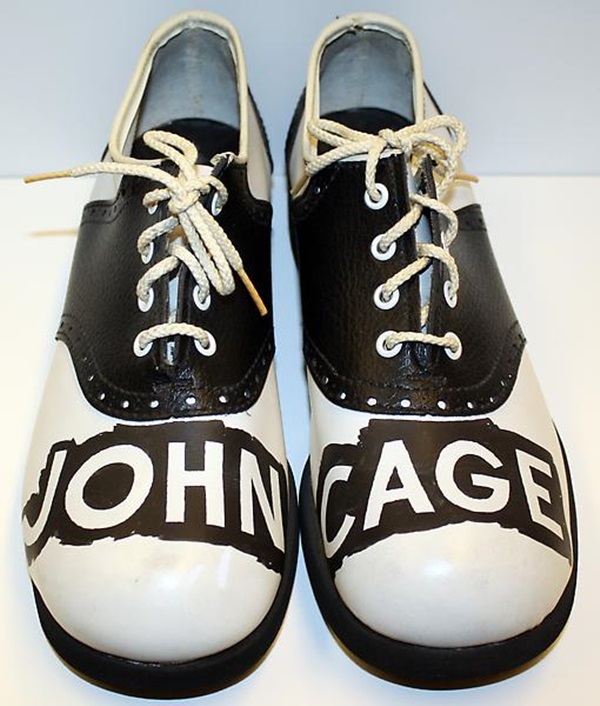
Ray Johnson, A Shoe (John Cage Shoes) (1977) at Feigen Gallery.
Photo: Feigen Gallery.
2.) Ray Johnson, A Shoe (John Cage Shoes) (1977) in “Ray Johnson’s Art World,” on view at Feigen Gallery, New York, through January 16, 2014.
The late Fluxus artist and Correspondance (sic) School founder Ray Johnson, created this inspired sculpture of altered saddle shoes as a tribute to his friend, the artist and musician extraordinaire John Cage. “We all dance in John Cage shoes,” Johnson supposedly remarked in 1975. After Johnson’s death in 1995, this most personal of artworks was discovered in the artist’s home-studio. Hilarious and poignant, given the playful nature of Cage’s work and his relationship to dancer Merce Cunningham, it is a highlight of “Ray Johnson’s Art World,” and a key Johnson work that I had never seen in person before. It stood out among other amazing pieces in this museum-quality exhibition exploring Johnson’s multifaceted connections to his artist peers.
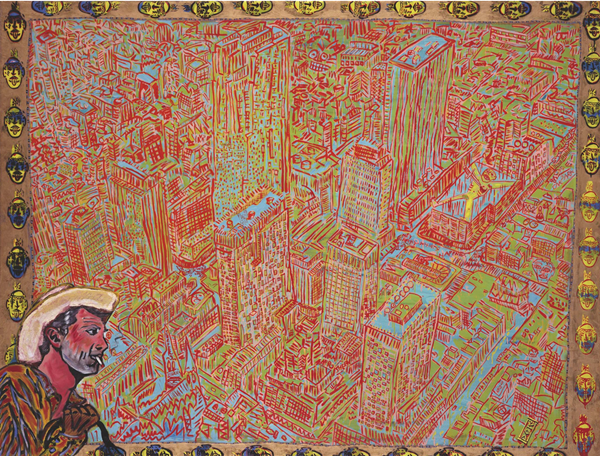
Peter Doig, I think it’s time…, (1982–83) at Michael Werner.
oil on canvas, 71 × 93 ¾ inches
Photo: Michael Werner.
3.) Peter Doig, I think it’s time…, (1982–83) oil on canvas, in “Peter Doig: Early Works,” at Michael Werner last winter.
This large, early painting by Peter Doig helped usher in the year 2014 for me when it appeared in New York for the first time last winter. It’s quickly becoming one of my favorite paintings ever. This richly colored and textured work featuring a schematic cowboy image on the lower left, and rows of Indian heads forming a border, struck me on many levels. Some of them are personal, having to do with conflicted feelings about the Cowboys and Indians motif, and my own Native American heritage (one-eighth Delaware Valley/Lenape). But in broader terms, the work addresses the cowboy mentality that has spawned so much urban gun violence today. Look at Doig’s ruined metropolis— it’s nearly a ghost town. There is a terrifying beauty to the place, exquisitely rendered as a scene of human sacrifice.
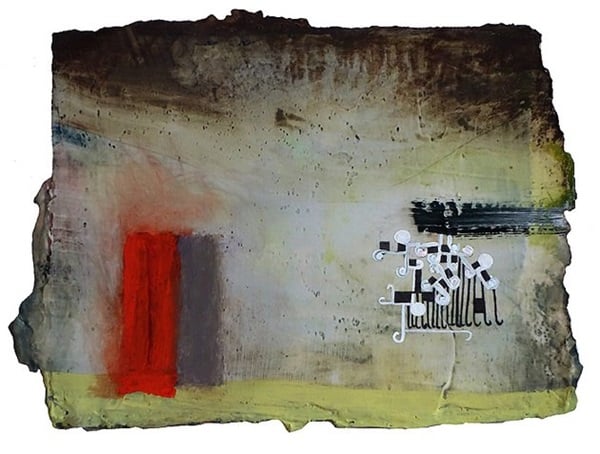
Jennifer Wynne Reeves, Joseph (2013) at BravinLee programs.
mixed media painting
Photo: BravinLee programs.
4.) Jennifer Wynne Reeves, Joseph, painting, (2013) in her solo show at BravinLee programs, Volta Art Fair, New York, last spring.
The late painter Jennifer Wynne Reeves was a wonderful artist and a charismatic individual. She was adventurous in her work, exploring a kind of hyper-sophisticated, folk-art fusion, often with text. When she sat near the entrance to her solo show in the BravinLee programs booth at the Volta Fair in New York last spring, she greeted visitors with her usual warmth and wit. It was difficult to believe that it would be the last show of her works she would attend. Reeves died just weeks later, June 22, at 51 from brain cancer. Among the most remarkable art works she left behind are the late paintings, such as Joseph, with its enigmatic spatial relationships and cryptic iconography, which was featured in the Volta show.
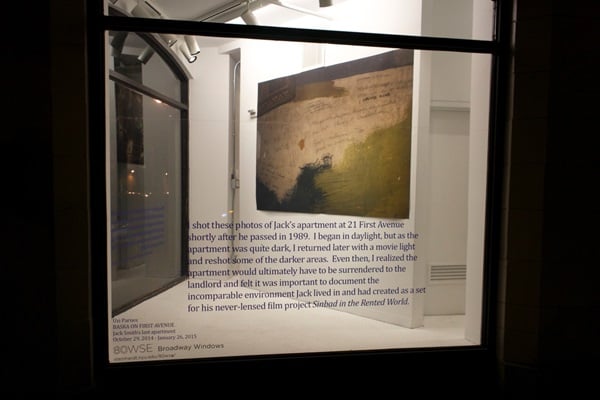
Uzi Parnes, photo installation, “Basra on First Avenue: Jack Smith’s Last Apartment,” (2014) at 80WSE Gallery.
Photo: Uzi Parnes.
5.) Uzi Parnes, photo installation, “Basra on First Avenue: Jack Smith’s Last Apartment,” at 80WSE Gallery at New York University,” on view in New York, through March 6, 2015.
You can’t get much more public than this installation by photographer, filmmaker, performance artist, and actor Uzi Parnes. The work is visible from the street, at Broadway and 10th Street, 24 hours a day, seven days a week. There’s the sensation of peering into someone’s apartment, and that’s what Parnes had in mind. A friend of the late avant-garde filmmaker Jack Smith, best known for his sexy and scandalous 1963 landmark Flaming Creatures, Parnes shot these photos in Smith’s art and memorabilia-packed apartment the day after he died of complications from AIDS in 1989. The large blow-up images and the way they are installed here convey the crazy exoticism of Smith’s intimate surroundings and his unique mind-set. This is better than most of the posthumous exhibitions of Smith’s work I’ve seen.
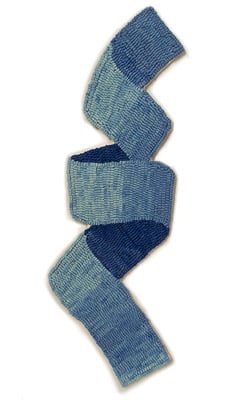
Altoon Sultan, Blue Ribbon (2013),
wool on linen
Photo: McKenzie Gallery.
6.) Altoon Sultan, textile piece: Blue Ribbon, wool on linen (2013), included in her solo show at McKenzie Gallery, New York, last fall.
Altoon Sultan’s exhibition of recent works at McKenzie Gallery was one of my favorite shows of the year. Her intimate-scale, jewel-like paintings of details of farm machinery are among the best works of hers I’ve seen. Her meditative mandala-like abstract paintings on paper, inspired by Islamic calligraphy and Tantric Buddhist art, are radically different in formal terms yet consistent in feeling and tone. The bravura works that stole the show were new textile pieces—simple shaped compositions of wool on linen, using a technique similar to a hooked rug, such as Blue Ribbon. These elegant objects pay homage to the history of postwar abstraction, particularly minimalism, although Sultan adds to the tradition something entirely fresh and unexpected.
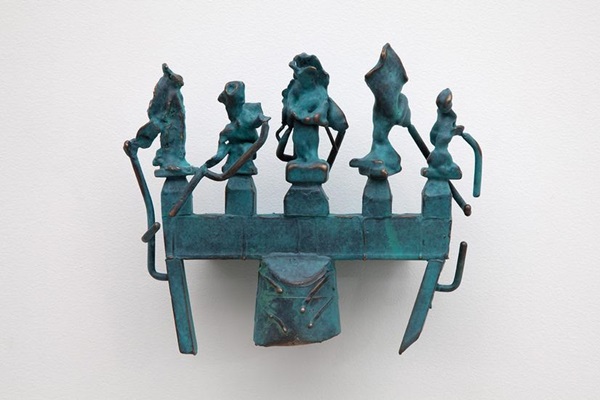
Charles Long, Bluedral (2014), patina on bronze 10 ¼ × 12 × 4 ½ inches.
Photo: Tanya Bonakdar.
7.) Charles Long, Bluedral, a bronze wall relief sculpture included in his “Up Land” show at Tanya Bonakdar, New York, last fall.
Most of the recent works in Charles Long’s terrific “Up Land” show appeared as topological explorations of landscape and nature forms. The small, cast-bronze wall relief Bluedral stood out among a number of exceptional pieces in the exhibition that reference the figure. Like a timeworn remnant from some forgotten civilization, this object, with a deep blue-green patina, featuring five ghostly figures, suggests a ritual object that will likely reveal its purpose pending further archaeological investigation. Unmoved by any trends other than his own, the Los Angeles–based artist, in works like this, arrives at a new and promising juncture in his already impressive career.
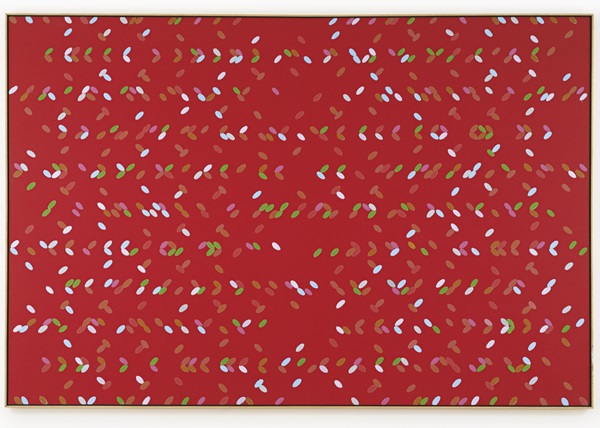
Larry Poons, Little Sangre de Cristo (1964)
acrylic on canvas, 90 × 135 inches.
Photo: Sotheby’s.
8.) Larry Poons painting, Little Sangre de Cristo (1964), sold for $1.2 million at Sotheby’s auction of contemporary art on November 12.
Long overdue for a career museum retrospective, living legend Larry Poons caused a stir in the art world early on in his career, in the 1960s, while still in his 20s, with a series of brilliant paintings featuring colorful hard-edge dots and lozenge shapes that pulsate against contrasting colored grounds. He made only 44 of these works before switching to a looser style of Color Field painting because, as he later said, his followers too often mistook them for works of Op art. One of his masterpieces from 1964, the large Little Sangre de Christo, showed up at a fall auction at Sotheby’s this year. The vibrant work broke Poons’s all-time auction record when it sold for $1.2 million, crushing its $200,000 high estimate. Hopefully, now that Poons has entered the million-dollar club, museum curators and the public will finally take notice.
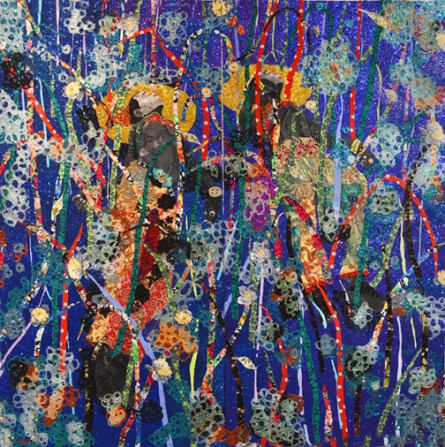
Ebony G. Patterson, …wata marassa-beyond the bladez (2014),
mixed media on paper, 2 parts, 85 × 84 inches.
Photo: Prospect 3
9.) Ebony G. Patterson, painting/assemblage: …wata marassa (2014), included in Prospect 3: Notes for Now, on view in New Orleans, through January 25, 2015.
One of the brightest new stars showcased in Prospect 3 in New Orleans this year, Jamaican artist Ebony G. Patterson dazzled audiences with a group of new works she presented at Tulane University. These glittering paintings on large sheets of paper correspond to sequin textile constructions often found in Caribbean art. One of Patterson’s dense compositions, such as …wata marassa-beyond the bladez (2014), a mixed media on paper work, is totally mesmerizing as pure visual sensation. Only after extended viewing does one discern the prostrate bodies of black male figures enveloped by lush foliage, and grasp a sense of the violence and foreboding that underlie Patterson’s seemingly bucolic vision.
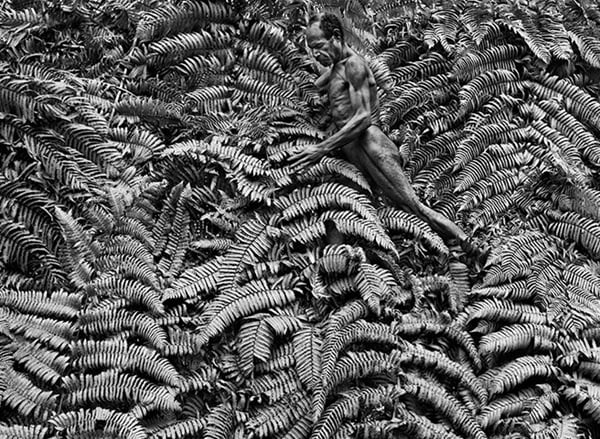
Sebastião Salgado, A Yali man in the Jayawijaya mountains of Irian Jaya (2010), still from the film The Salt of the Earth; related photograph in “Genesis.” ICP, New York.
Photo: ICP.
10.) Sebastião Salgado, photo: A Yali man in the Jayawijaya mountains of Irian Jaya, still from the film The Salt of the Earth; a related photograph appears in Salgado’s “Genesis” survey at the International Center of Photography, New York, through January 11, 2015.
It was a big year for Brazilian photographer Sebastião Salgado. A documentary feature film about his life and work, The Salt of the Earth, co-directed by Wim Wenders and Salgado’s son, Juliano, opened in theaters in December to qualify for the Oscars (the film’s general release is scheduled for March 27). And the International Center of Photography (ICP) presented his massive and ambitious series of works from the past decade, “Genesis,” a touring museum show on view in New York through January 11, 2015. The breathtaking images in this show, taken on remote locations all over the world, constitute an impassioned plea to save the planet from impending human destruction. One of the most arresting and unforgettable photographs, Yali Man, West Papua, Indonesia (2010), shows a man enmeshed in a fern forest. Here, for just a moment, humanity achieves a perfectly balanced, symbiotic relationship with nature.